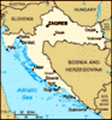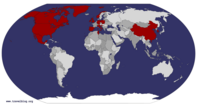Advertisement
Published: November 30th 2014
What did I know about Croatia, the country, the landscape, the people before we went there? - Not much, probably a very little bit about history but still not much. Probably a bit about the landscape: A friend showed his photos to us, he has traveled to Croatia several times. And the people? Time to explore some more, even if time is limited. It was quite interesting to meet three types of people, the young shuttle bus driver (who was looking for a job), the middle-aged landlord (who converted to Christianity, because he was disappointed with and not amused by the communist government in the past) and the old man (who was a Titu supporter). Three views of Croatia now and then, which gave us a very small insight into the Croatian soul...
Our holiday home was on the ground floor of the landlord's house in
Okrug Gornji on the island Ciovo (close to Trogir). He picked us up at the airport in Split by car and showed us some parts of the island on the way to the house. Afterwards he helped us with the grocery shopping. And showed us the "Capacabana beach" and we talked about
Croatia's history, why he became Christian and that the politicians in the Croatian government are too old and too "red". He also believes that Croatia has great economical potential, which is not used so far. The weather was a bit rainy, but in the end, this made the temperatures fall to still enjoyable 30°C. In the afternoon we wanted to explore the coastline and walked eastwards (from Okrug Gornji). First, we passed Vela Draga, a pebble beach, which was unfortunately a bit crowded. A little more east there was the smaller pebble beach, Mala Draga. No one was there! The water was crystal clear and some trees offered shady spots. You can see the island Brac, and sometimes smaller or bigger ships passed by in the distance. It - was - just - beautiful.
Trogir itself was our target for the second day.
Trogir, formerly known as Tragurion, was founded in the 3rd century BC by Greek colonists. Funny trivia: the name comes from the Greek word "tragos", which means male goat. Trogir became a major port until the Roman period. Because of the important historical sites, it was inscribed on the UNESCO list of world heritage

 Snorkeling
Snorkeling
It was a lot of fun, and we saw quite many sea urchins (so it was necessary to wear water shoes). New item on my wishlist: underwater camera :)in 1997. The medieval core is the best-preserved Romanesque-Gothic complex in central Europe, most of the buildings date back to the 13th century or later. Like many other visitors, we enjoyed the beauty of this city. We had delicious ice cream, went to the market in Trogir, and found an alley with small shops which sold nice handmade gifts. One of the shops had homemade olive oil, herbs, liquor, and soap. I bought some olive oil for my mum and she loved it! I can only recommend strolling through the small alley left and right of the main way, there are beautiful backyards, small restaurants, and good shops. To see all of Trogir's sights you may need only a day, to see all of its beauty some longer time. The evening we spend, as usual, swimming and snorkeling. I did not try snorkeling before, but at home I had goggles and a snorkel, which wanted to be tested 😊 At this point, I added a new item to my wishlist: an underwater camera!
The third day was a "walking day": we went to
Okrug Donji. It was very hot and sunny as we "hiked" the hill Gnilovaca,

 Ciovo's coastline from the airplane
Ciovo's coastline from the airplane
Most of the coastline of Ciovo was rocky beach, but there were also some coarse pebble beaches.so a hat is definitely a "must have". Okrug Donji is smaller than Okrug Gornji, and also had a nice coastline and paths close to the water. For the way back to Okrug Gornji we decided to follow such a path. It was supposed to cross another path, and we had to turn left. But the map and the reality were two different worlds: there was no path to our left. At some time, as we followed the path along the coastline, we went left uphill through undergrowth and boulders. Halfway uphill we gave up, my legs were scratched and we were running out of water. So we returned to Okrug Donji. One lesson learned: paths on the map do not necessarily exist in real life. The same holds for lighthouses: we were looking for one at the westernmost point of Okrug Donji/ Ciovo, but the only lighthouse around was on a small island around 200 m away from the coast.
We reached half-time of the vacation! Time for the pre-booked trip to
Krka Nationalpark on our fourth day. First of all, we got the info that it is (differently from what we were told) only a
shuttle service to the park, no guide included. So the driver (actually a field surveyor during the off-season) brought us to the big parking lot in front of the park. By boat we were supposed to go to a landing close to Skradinski Buk (big waterfalls). But, the reserved boat was already full and other boat tours were also fully booked for hours. So the shuttle dropped us off right at the entrance to the walking path around Skradinski Buk and we had 4,5 hours to explore and enjoy. One round of the walking path only took 30-45 minutes, so we went swimming. In the morning there are not that many people, in the afternoon it is quite stuffed! In the water area close to the waterfall (which is left of a big pedestrian bridge) are usually more people than on the right side of the bridge. Skradinski Buk itself has a has 17 waterfalls and the difference in height between the first and the last fall is about 48 meters. The area has a length of 400 meters and a width of 100m. The waterfall formed along the river Krka (as you can see in the areal picture). The
park itself is extremely rich in flora (860 species/subspecies of plants) and fauna (abundance of bird species). The NP offers the visitor to experience former times in the Ethno Village, with a blacksmith, weaving mill, grain mill, ... On the way back to Trogir we stopped in
Sibenik (a beautiful old town with small alleys and the famous Cathedral of St. Jacob) and
Primosten (small, round, nice shops and lovely handmade souvenirs). We talked to our driver a bit, he was normally a land surveyor but he is waiting for a job at the moment so he helps his friend with his shuttle service for tourists. This way he earns some money, more than with his usual job. He was an Okrug Gornji local and stayed there all his life.
History was on our schedule for the fifth day: we went to the
Roman ruins of Salona. Salona was a former Roman city that dates back to 400 BC. We got there by bus. Bus 37 from Trogir to Split stopped in Solin, where we dropped off. The easiest way to get to the ruins is as follows: we crossed the street and walked some meters along
the street (direction Trogir). At the traffic sign, we turned right and walked along the way through the allotment site. This way brought us right to the south entrance of the ruins. Afterwards, we realized that this was not an official entrance because more uphill you had to pay entrance fee. The ruins were partly preserved. The site contains the episcopal center, the thermae, the city wall, and churches. A well-preserved amphitheater was just a 10-minute walk away, it used to have place for 15000 (!) people. In the photo, it seems less spectacular, but there you see only a part of the lower tribunes. Salona itself used to have an elliptical shape, 700 m wide and 1,6 km long. The city walls had a width of 1,9m to 2,5 m! Massive! In the 19th century, these buried remains of ancient Salona were excavated. For visitors interested in ancient ruins and history Salona definitely is a "must-see".
The sixth day we spend on the island
Drvenik Mali, which can be reached by ferry. It is very small and has only 50 inhabitants. The ferry tickets can be bought in Trogir at the Jadrolina office. On the ferry,
we were surprised because suddenly everyone stood up and looked onto the water's surface. What was happening? There were dolphins, yes, dolphins! I was too slow to take a good picture, but even on the one I took you can see the tail fin.
When we arrived in Drvenik Mali we first wanted to go swimming at Vela Rina beach, but we did not like the location and kept looking for a nice swimming spot. On our way we met an old Croatian man from the island, who spoke fluent German since he also used to work there. He invited us to his house and offered us something to drink. We were surprised by the hospitality. We went swimming and he asked us to come back afterwards to have some food. So we walked in the midday sun to Matusin Bok, which was very hard to find. Only a small, mainly hidden path brought us down to the bay. But once we found it, it was soooo beautiful! Crystal-clear water, unspoiled coast, and no other visitors around. A perfect swimming spot (photos!). We spend 3 hours swimming and snorkeling. Back at the Croatian's house, he offered us bread with
homemade gammon, tomatoes from his garden, and water. He liked to talk about Croatia, his work in Germany, his family, and answered our questions about the island and Trogir. He was a supporter of Tito and was proud of Tito's picture in his kitchen. But every day has an end, and there was only one evening ferry. So we went back to Trogir and called it a day.
Sibenik was the destination for our last day. We went there by bus, the tickets can be purchased at the main bus station. Just like Trogir the town is very beautiful, with small alleys (usually too small for cars), restaurants, cafes, shops, many very old, well-preserved buildings, and green backyards. A very good view on the city offered the graveyard just beside the castle of St. Michael.
Advertisement
Tot: 0.099s; Tpl: 0.013s; cc: 13; qc: 29; dbt: 0.0387s; 1; m:domysql w:travelblog (10.17.0.13); sld: 1;
; mem: 1.1mb





















